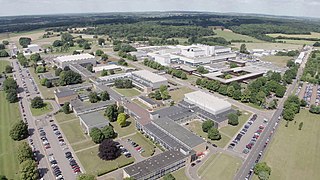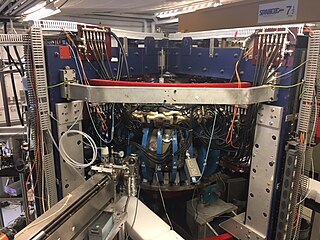
An operating system (OS) is system software that manages computer hardware, software resources, and provides common services for computer programs.
VME is a mainframe operating system developed by the UK company International Computers Limited. Originally developed in the 1970s to drive ICL's then new 2900 Series mainframes, the operating system is now known as OpenVME incorporating a Unix subsystem, and runs on ICL Series 39 and Trimetra mainframe computers, as well as industry-standard x64 servers.

Electronic test equipment is used to create signals and capture responses from electronic devices under test (DUTs). In this way, the proper operation of the DUT can be proven or faults in the device can be traced. Use of electronic test equipment is essential to any serious work on electronics systems.
The X band is the designation for a band of frequencies in the microwave radio region of the electromagnetic spectrum. In some cases, such as in communication engineering, the frequency range of the X band is rather indefinitely set at approximately 7.0–11.2 GHz. In radar engineering, the frequency range is specified by the Institute of Electrical and Electronics Engineers (IEEE) as 8.0–12.0 GHz. The X band is used for radar, satellite communication, and wireless computer networks.
General Electric Automation and Controls division combines what was formerly known as GE Intelligent Platforms and Alstom's Power Automation and Controls. In 2019, GE Intelligent Platforms was acquired by Emerson Electric and is now called Machine Automation Solutions.

FANUC is a Japanese group of companies that provide automation products and services such as robotics and computer numerical control wireless systems. These companies are principally FANUC Corporation of Japan, Fanuc America Corporation of Rochester Hills, Michigan, USA, and FANUC Europe Corporation S.A. of Luxembourg.

The ICL 2900 Series was a range of mainframe computer systems announced by the UK manufacturer ICL on 9 October 1974. The company had started development, under the name "New Range" immediately on its formation in 1968. The range was not designed to be compatible with any previous machines produced by the company, nor with any competitor's machines: rather, it was conceived as a synthetic option combining the best ideas available from a variety of sources.
Direct digital control is the automated control of a condition or process by a digital device (computer). Direct digital control takes a centralized network-oriented approach. All instrumentation is gathered by various analog and digital converters which use the network to transport these signals to the central controller. The centralized computer then follows all of its production rules and causes actions to be sent via the same network to valves, actuators, and other heating, ventilating, and air conditioning components that can be adjusted.
Sinec H1 is an Industrial Ethernet communications protocol that provides the transport layer function widely used in automation and process control applications. The protocol was developed by Siemens and is used mainly for control applications. It has large bandwidth and is well suited to the transmission of large volumes of data.
The Time-Triggered Ethernet standard defines a fault-tolerant synchronization strategy for building and maintaining synchronized time in Ethernet networks, and outlines mechanisms required for synchronous time-triggered packet switching for critical integrated applications, IMA and integrated modular architectures. SAE International has released SAE AS6802 in November 2011.

Cloud computing is the on-demand availability of computer system resources, especially data storage and computing power, without direct active management by the user. Large clouds often have functions distributed over multiple locations, each location being a data center. Cloud computing relies on sharing of resources to achieve coherence and economies of scale, typically using a "pay-as-you-go" model which can help in reducing capital expenses but may also lead to unexpected operating expenses for unaware users.
A software widget is a relatively simple and easy-to-use software application or component made for one or more different software platforms.
Eurotech is a company dedicated to the research, development, production and marketing of miniature computers (NanoPCs) and high performance computers (HPCs).
A smart TV, also known as a connected TV (CTV), is a traditional television set with integrated Internet and interactive Web 2.0 features, which allows users to stream music and videos, browse the internet, and view photos. Smart TVs are a technological convergence of computers, televisions, and digital media players. Besides the traditional functions of television sets provided through traditional broadcasting media, these devices can provide access to over-the-top media services such as streaming television and internet radio, along with home networking access.
Service Request Transport Protocol (GE-SRTP) protocol is developed by GE Intelligent Platforms for transfer of data from programmable logic controllers. The protocol is used over Ethernet almost all GE automation equipment supports the GE-SRTP protocol when equipped with an Ethernet port. Any SRTP client will be capable of reading and writing system memory of any number of remote SRTP capable devices.

The Culham Centre for Fusion Energy (CCFE) is the UK's national laboratory for fusion research. It is located at the Culham Science Centre, near Culham, Oxfordshire, and is the site of the Joint European Torus (JET), Mega Ampere Spherical Tokamak (MAST) and the now closed Small Tight Aspect Ratio Tokamak (START).
White Rabbit is the name of a collaborative project including CERN, GSI Helmholtz Centre for Heavy Ion Research and other partners from universities and industry to develop a fully deterministic Ethernet-based network for general purpose data transfer and sub-nanosecond accuracy time transfer. Its initial use was as a timing distribution network for control and data acquisition timing of the accelerator sites at CERN as well as in GSI's Facility for Antiproton and Ion Research (FAIR) project. The hardware designs as well as the source code are publicly available. The name of the project is a reference to the White Rabbit appearing in Lewis Carroll's novel Alice's Adventures in Wonderland.

The Hybrid Illinois Device for Research and Applications (HIDRA) is a medium-sized toroidal magnetic fusion device currently being assembled within the Center for Plasma Material Interactions in the Department of Nuclear, Plasma and Radiological Engineering at the University of Illinois at Urbana–Champaign, United States. It is anticipated that HIDRA will have first plasma by mid-September 2015 and start full experimental campaigns by December of that year. HIDRA is the former WEGA classical stellarator that was operated at the Max-Planck Institut für Plasmaphsyik in Greifswald Germany from 2001 to 2013.

GE Digital is a subsidiary of the American multinational conglomerate corporation General Electric. Headquartered in San Ramon, California, United States, the company provides software and IIoT services to industrial companies.







